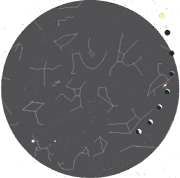 |
|
Sky Watch by J. Alex Knoll It’s Heating Up in Our Night SkyBut then why is the sun so far away?
As darkness descends, lights explode into view, and they’re not fireworks. While we celebrate our independence each Fourth of July, the planets and stars shine overhead in many-hued colors on any clear night. Sunset reveals three bright lights low in the west, each less than three degrees from the next. The highest, brightest and first to appear is golden Saturn. Next is ruddy Mars, followed by blue-white Regulus, the heart of Leo the Lion. Saturday, the waxing crescent moon hovers about six degrees below Regulus. The next evening, the moon’s upper tip is five degrees from Saturn. With the new week, Regulus sinks lower and sets earlier, while Saturn and Mars pull closer together, coming within one-half degree of one another Wednesday the 9th. Opposite these three, Jupiter crests the southeast horizon, shining far brighter than any star and all other planets except Venus, which is obscured by the sun. Jupiter’s opposition this week — its point opposite the sun in relation to Earth — means that the gas giant rises at sunset and sets at daybreak, traveling a lazy arc through the south in between. July 5th marks Earth’s aphelion, its farthest point from the sun. You may wonder why, if that’s the case, July marks one of our hottest months. It turns out that Earth’s distance from the sun, which varies by only 1⁄30th from its farthest to its closest, has little to do with the temperature. Instead, our planet’s 231⁄2-degree tilted axis makes all the difference: for us in the Northern Hemisphere, far more sunlight hits us this time of year, creating longer days and much more heat. Illustration: © Copyright 1925 M.C. Escher/Cordon Art-Baarn-Holland; Graphics: © Copyright 2007 Pacific Publishers. Reprinted by permission from the Tidelog graphic almanac. Bound copies of the annual Tidelog for Chesapeake Bay are $14.95 ppd. from Pacific Publishers, Box 480, Bolinas, CA 94924. Phone 415-868-2909. Weather affects tides. This information is believed to be reliable but no guarantee of accuracy is made by Bay Weekly or Pacific Publishers. The actual layout of Tidelog differs from that used in Bay Weekly. Tidelog graphics are repositioned to reflect Bay Weekly’s distribution cycle.Tides are based on National Oceanic and Atmospheric Administration and are positioned to coincide with high and low tides of Tidelog. |
|
|
|
|
|
© COPYRIGHT 2008 by New Bay Enterprises, Inc. All rights reserved. |


